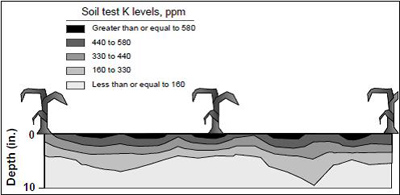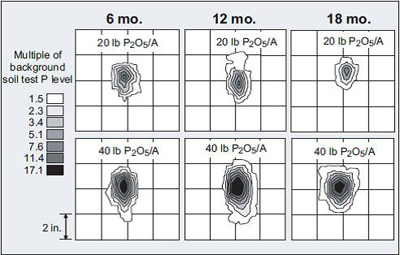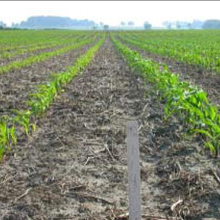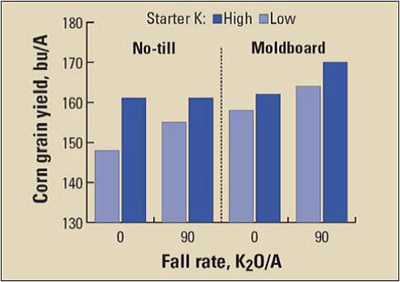
Figure 1. Soil test K stratification in an Iowa field after 10 years of no-tillage. Lines are soil test K levels in parts per million (Robbins and Voss, 1981).
According to the Conservation Technology Information Center, conservation tillage has replaced a significant portion of conventional tillage acres. Does conservation tillage change the way we need to manage phosphorus (P) and potassium (K) fertilizers?
The hallmark of reduced tillage is nutrient stratification
Less mixing of the soil — combined with surface applications of P and K and release of nutrients from crop residues — results in higher soil nutrient concentrations near the surface than just a few inches below (Figure 1). Rain leaches K out of crop residues more quickly than P, because much of the P is bound in organic forms. Eventually, however, both nutrients accumulate at the soil surface when the residues are left on top.

Figure 2. Phosphorus moves slowly outward from a band of liquid starter placed beside and below the seed of corn planted in Missouri. The band was still enriched after the harvest of the following soybean crop (Stecker et al., 2001).
In addition to vertical stratification, horizontal stratification also occurs with banded fertilizer applications. Bands of fertilizer are most concentrated immediately after application and become more diffuse over time (Figure 2). Potassium bands become diffuse more quickly than P bands, due to the faster diffusion rates of K.
Fertilizer applied in bands near the seed at planting provides a concentrated supply of nutrients strategically placed for easy access by young root systems.This application, termed “starter,” has proven beneficial across a wide geography for nitrogen (N) and P for corn and wheat when early season conditions are cool and wet — conditions often found in reduced tillage systems in northern climates. Research on corn, from the Midwest and from Ontario, suggests that a “complete” starter (one that contains N, P and K) is needed for maximum benefit.

On-farm research in Ontario shows the advantage of starter fertilizer in no-till corn following soybeans. The right side shows 150 pounds per acre of 0-20-20 in a 2×2 band along with 5 gallons per acre of liquid 6-24-6 in the seed furrow. The left side had none
Research on soils that had been in continuous no-till for six or more years showed that corn response to starter K was consistently stronger when the no-till practice was continued, compared with disturbing it with fall moldboard plowing (Figure 3). The tillage may have made soil K more available by mixing up the stratified layers or by influencing rooting patterns. Bands of P applied deeper in the soil than depths typical of starter applications have produced mixed results. In reduced tillage systems in the Midwest, deep band applications below the row usually produce as much corn and soybeans as broadcast applications. Occasionally, they are superior, such as in especially dry growing conditions.
In contrast to P, K’s deep bands can provide more consistent yield benefits to corn than broadcast applications in ridge-till, no-till and chisel-till systems .Keep in mind that K does not promote root proliferation the way N and P do. Consequently, N, P (or both) should be applied with banded K to ensure roots access as much of the banded K as possible.
Conservation tillage may also affect nitrogen management.
Optimum N rates may be higher in no-till (West and Marland, 2002, estimate an average of 38 pounds per acre more), or they may not differ from those with disk or plow tillage (Shapiro and Walters, 1998). It is particularly the soils that accumulate organic matter in response to reduced tillage that likely need more N. Placement below the soil surface is generally considered important (Vetsch and Randall, 2000).

Corn grain yield response to K applied in the fall or as a spring starter in Ontario on a silt loam soil with 65 to 90 ppm exchangeable K. Average of three years, 1996–1998 (Vyn et al., 1999).
With the advent of automatic guidance systems and the ability to record locations of fertilizer bands, farmers gain new options for managing banded fertilizer applications. Now, instead of randomly applying then forgetting fertilizer band locations, farmers can match band spacing to a number of different row widths in the same field by changing their locations over time. Further, they can plant crops at any given distance from previously applied bands by using new guidance technology.
Conclusion
Nutrient stratification in reduced tillage systems, along with cooler early spring soil temperatures and higher soil moisture, can lead to profitable crop responses to banded applications of N, P, and sometimes K near the seed. Midwest research indicates that placement of bands deeper in the soil produces more consistent benefits for K than for P.
References
Robbins, S.G. and R. Voss. 1991. Phosphorus and potassium stratification in conservation tillage systems. J. Soil Water Conserv. 46:298–300.
Shapiro, C.A. and D.T. Walters. 1998. Effect of tillage, rotation, and nitrogen rate on rainfed corn yield and nitrogen uptake. Proc. North Central Ext. – Ind. Soil Fert. Conf., St. Louis, Mo.
Stecker, J.A., J.R. Brown, and N.R. Kitchen. 2001. Residual phosphorus distribution and sorption in starter fertilizer bands applied in no-till culture. Soil Sci. Soc. Am. J. 65:1173–1183.
Vyn, T.J. and K.J. Janovicek. 2001. Potassium placement and tillage system effects on corn response following long-term no till. Agron. J. 93:487–495.
Vyn, T., Janovicek, K. and T. Bruulsema. 1999. Banded potash boosts no-till corn yield. Better Crops 83(3):8–9.
Vetsch, J.A. and G.W. Randall. 2000. Enhancing no-tillage systems for corn with starter fertilizers, row cleaners, and nitrogen placement methods. Agron. J. 92(2):309–315.
West, T.O. and G. Marland. 2002. A synthesis of carbon sequestration, carbon emissions, and net carbon flux in agriculture: comparing tillage practices in the United States. Agric. Ecosyst. and Environ. 91:217–232.
Article courtesy of PPI, authored by Dr. Tom Bruulsema, Northeast Region director, and Dr. Scott Murrell, Northcentral Region director.